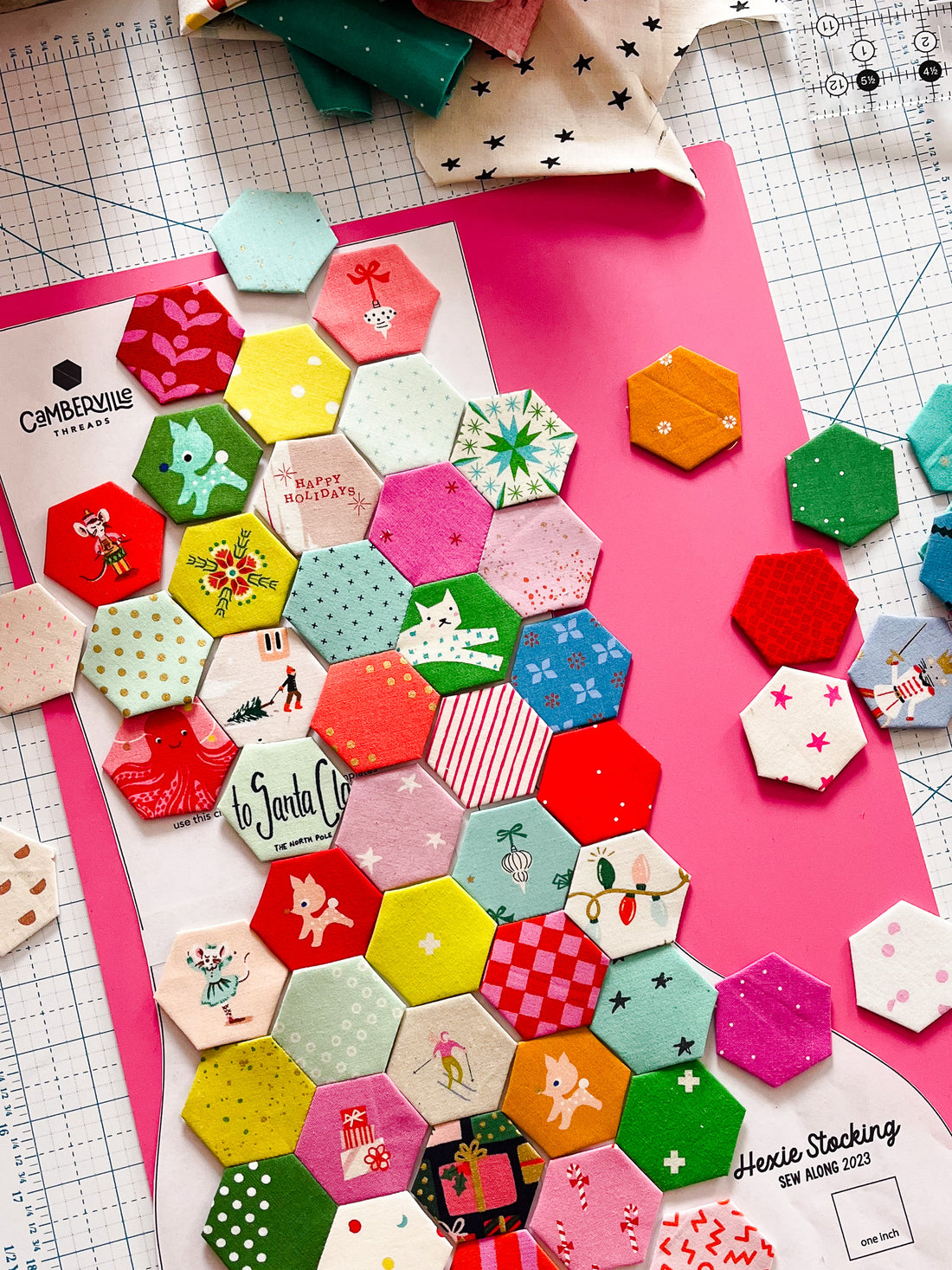
Christmas Hexie Stocking Sew Along Week 2: Stitching Hexagon Columns
Share
Welcome to Hexie Stocking Sew Along Week 2!
Hopefully you are well on your way to a nice pile of basted hexies, but no worries if you are working at a different pace, the sew along will live here on the blog and you can come back to reference it whenever you need - even if you’ll be doing Christmas in July 🙂
This week we will be sewing our hexagons into columns.

If you haven’t downloaded the free stocking template yet, be sure to do that here. The stocking is tiled over 4 US letter sized pages which you will need to print and tape together. Double check that you are printing at 100% by referencing the 1” box on the template. The stocking finishes at about 18” tall.
Something to note - I have my stocking with the toe pointing right (to match my other handmade stockings). You can flip the template if you want the toe pointing the opposite way, just be sure to reverse the hexie stitching layout as well.
Hand Stitching Supplies
A quick round up of the tools you’ll need this week: needle, thread, snips. So simple! You’ll also need your basted hexagons (more on that in week one).
Over the course of my EPP journey I’ve tested a lot of products and settled on some favorites which I’ll share with you if you are looking for a few options to make your stitching a bit smoother.

My favorite thread for EPP is Wonderfil Decobob 80wt poly thread. I really never thought I would stray from cotton but I gave this thread a shot and I was hooked! It's fine so it melts into your fabric but the poly is strong. It is also treated to behave more like cotton so it's not shiny or stretchy like a typical polyester thread would be. My secret hack for sewing on the go? Using prewound bobbins in my travel bag - compact but plenty of thread!
If you are using cotton thread you may want to use a thread gloss to minimize snags.
For needles - I prefer using Milliners Needles aka Straw needles in size 11. The needles are sharp, long and thin and a bit flexible which I find very helpful when stitching.
Snips - I have a plethora of thread snips some cute some super functional and whichever I can locate in that moment is the best one for the job ;)
A couple of nice to have items:
The Clover Desk Needle Threader. Threads those tiny eye needles like magic, no squinting!
Another item that I don’t like to stitch without are SewTites, magnetic “pins” that hold your pieces in place so you don’t grip your work too tight - do yourself a favor and save your hands and fingers!
Ok, now that we’ve got your supplies squared away, onto assembly.
EPP Basics: Whip Stitch
This week is all about stitching. Are you familiar with how to sew hexagons together? If you are new or need a refresher, continue below. If you are confident in your stitching feel free to jump ahead to the layout diagram and begin planning!
Select two hexagons to stitch together and align them placing right sides together making sure the corners are matched as best as possible. This top edge will be our first seam. If you are using directional fabric note which way is up.
Thread your needle with about 12-16 inches of thread. I like to knot the end of my thread so it doesn’t pull through on me but you can leave a tail instead. Wrap the thread around your pointer finger one or two times and then roll it off your finger and pull to form a knot.
Bring your needle through the very corner of both hexagons perpendicular to the edge in the space between the edge of the paper and the fold of the fabric. This is a very small “bite” only 2 threads or so wide from each hexagon.

Take a second stitch in the same place but before pulling your thread all the way through pass your needle twice through the loop it forms and pull to create a knot. Now you are anchored and ready to begin. On each corner as you start or stop a seam you will secure your stitches- think of it like saving your work.

Bring your needle around the seam back to the initial side and take another stitch through the fabric this time just slightly further up. Whipstitch up the edge of the hexagons taking about 12 -16 stitches per inch. Keep your needle perpendicular to the edge as you pass through the hexagons so the smallest amount is showing on the front of your work, this will help hide your stitches.
(Shown below in contrasting thread so the stitches are easier to see but use a matching or neutral thread to help hide your stitches.)

Make sure to pull your stitches together securely - don’t yank on the thread but don’t leave it too loose either or your pieces will gap. When you get to the end take two stitches on the opposite corner and pull through the loop to form a knot and secure your work. Open up your pieces- you did it!

I stitch from the right to the left towards myself holding my work at an angle. Everyone holds their work differently so experiment and find out what is most comfortable for you.
Stocking Layout Diagram
You’ll need your basted pieces ready to go for this week! We are going to be sewing our hexagons into columns. Layout your hexagons according to the diagram. (If you'd like to view at full size you can download the layout here).
 I found it very helpful to play with the layout and then take a photo on my phone, to check placement and also to have a map of which pieces go where. Somehow despite keeping my columns separate and stacking each hexagon in order I seem to jumble the pieces and the picture is a great reference point to get everything back in order.
I found it very helpful to play with the layout and then take a photo on my phone, to check placement and also to have a map of which pieces go where. Somehow despite keeping my columns separate and stacking each hexagon in order I seem to jumble the pieces and the picture is a great reference point to get everything back in order.

Note, because we will be removing the papers and opening up the seam allowance on the outer edge to quilt, you may not need a few of the hexagons on the outside edge. I’ve included them so you have a little wiggle room when trimming as depending on your quilting, the final panel can shrink. As shown you’ll need 76 hexagons, though I think you can get away with 73.

When you are ready to stitch, take the top hexagon from your first column and flip it down on top of the hexagon below it, placing right sides together making sure the corners are matched as best as possible. This top edge will be our first seam. Stitch along that seam and repeat sewing each hexagon in the column end to end. (see below for a sewing hack to speed up this process a bit!)
Then repeat for each column. Yay! Set your columns aside and give yourself a high five!
EPP Tips & Tricks
EPP by nature is slow stitching, the methodic muscle memory is part of its appeal afterall. I have a few tricks to make sure your stitching is most efficient.
What takes the most amount of time when you are hand sewing? Starting and stopping! There are two ways to speed up your stitching- disclaimer both methods do use more thread but I’ve found the time savings worthwhile.
EPP Chain Piecing

Just like machine piecing you can chain stitch units to maximize the hexagons you can sew until you need to rethread.
Stitch your first seam, making sure to secure your stitches at each corner but don’t cut your thread. Leave a short trail of thread and begin sewing your next pair. Repeat making sure you begin and end each unit with a securing stitch.
Once you get to the end of your thread, cut your units apart. So much faster than all those stops & starts right? This is a great method if you are sewing scrappy and aren’t sure what is going where yet, just get into a groove plucking two hexagons from your pile and stitching them together.
EPP Thread Traveling

This is the method I love to use when stitching columns of hexagons - no more starts and stops between each seam!
Sew a pair of hexagons together like normal, making sure to secure your thread at the end of the seam but don’t cut your thread. Bring your thread under the seam allowance between the paper and the fabric. Travel across the paper and then under the opposite seam allowance and come out at the corner where you’ll begin your next seam. Line up your next hexagon and you guessed it, make sure to secure your stitch.
One caveat, you will have to clip your threads later so you can remove the papers, but I still find this quicker than constantly restarting a new line of stitching. I love a slow sewing evening on the couch, where I can get into a rhythm and stitch up my columns.
When you need to cut your thread make sure you are stopping on a corner. Secure your stitch. Pass your needle between the seam allowance and the paper for a 1/2 inch. Come up through the seam allowance and cut your thread close to the fabric so your work will stay tidy.

Practice Makes…Better
Like anything, the more often you stitch the more even your tension, stitch size and spacing will become. Soon you’ll be an EPP pro!
Stay tuned for next week where we’ll be sewing our columns of hexagons together, so you’ll have 2 weeks to sew your hexie panel in total.

